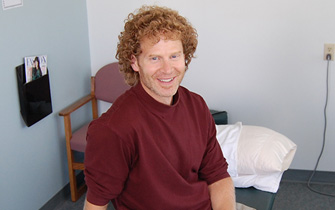If it hurts to talk, chew, or yawn, your temporomandibular joint (TMJ) could be the culprit.

TMJ is the hinge that connects your jawbone to your skull and allows you to open and close your mouth. Each time you talk, chew and yawn, your TMJ is at work. When this joint malfunctions, you may feel pain, stiffness, and ‘clicking’ or ‘popping’ sensations with these movements.
If you have been experiencing headaches, toothaches, dizziness or head pain anywhere from your teeth to around your eyes, you could be suffering from TMJ dysfunction.
About 20-30% of the adult population is troubled by this disorder, but many sufferers of this common disruption go without treatment — don’t let this be you!
What is TMJ?
Temporomandibular Joint Dysfunction (pronounced [tem-puh-roh-man-dib-yuh-ler]) is a common dysfunction that affects the area around the jaw.
Pain felt in the TMJ can be traced to issues in the surrounding muscles, ligaments, myofascial tissue, disc, joint capsule, or even degraded cartilage around the jaw. Some common causes of TMJ include:
- Jaw injuries (whether whiplash from a car accident or a direct blow)
- Arthritis
- Teeth grinding while sleeping
- Ill-fitting dentures
- Stress
How do I know I’m dealing with TMJ pain?
It can be difficult to correctly identify the source of the problem in someone with TMJ dysfunction because of the many systems that interact with the joint. It’s best practice to identify the source of your TMJ pain.
One source of pain in TMJ dysfunction originates from a misalignment of the joint that acts like a sliding hinge between the jawbone and the skull. This misalignment commonly originates from problems with the surrounding muscles, such as muscle imbalances, tight muscles/myofascial tissue or weakened muscles. When the two moving mechanisms fail to connect comfortably, all functions of the jaw become compromised, introducing pain to the area.
Another source of TMJ dysfunction stems from damaged nerve tissue at the branch of the trigeminal nerve that connects to the jaw. Also, ligament damage can be present, which if left untreated can cause a dislocation of the disc leading to disc derangement. A physiotherapist can look into the exact source of the problem and offer a carefully crafted treatment plan.
If you think TMJ dysfunction could be the root cause of your pain, ask yourself the following questions:
- Is the area around your jaw sensitive to touch, or feel increasingly uncomfortable when chewing, yawning or talking?
- Can you hear a distinctive popping, grating or clicking sound from the joint when you move your jaw and is there pain associated with these sounds?
- Is there sometimes a feeling as though movement in your jaw is limited when you attempt to open or move it?
If you answered yes to one or more of the questions above, and have been suffering from pain in the jaw area, you might benefit from talking to your physiotherapist about TMJ dysfunction.
TMJ Treatment Options
A variety of treatment approaches can be used to restore normal movement patterns in the jaw and relieve pain or discomfort. After examining the joint and understanding the causes of your TMJ Dysfunction, our physiotherapists will create a customized treatment plan that may include the following techniques:
- Joint mobilization: Manually moving the joint in specific directions can stretch scar tissue and release muscle and soft tissue tension, improving range of motion.
- Massage therapy: Massage therapy can reduce overall muscle tension in the body, especially in the jaw, neck, shoulders, and upper back.
- Craniosacral therapy: This technique is performed by massage therapists and can also be used to reduce the tension in the tissues affecting the jaw and restore normal TMJ mobility. Learn more about how craniosacral therapy can help treat your TMJ in our blog post.
- Myofascial release: This hands-on technique is performed by physiotherapists and targets the fascia, connective tissue wrapping around muscle, bone, and other structures within the body.
- Dry needling: Some patients find pain relief from traditional acupuncture treatments or intramuscular stimulation (IMS), in which acupuncture needles are placed directly in any muscles causing pain or dysfunction.
- Home exercises: Our well-trained physiotherapists can prescribe exercises designed to relax stiff muscles, improve range of motion, and teach you to move the joint properly.
- TENS: Transcutaneous electrical nerve stimulation (TENS) treatments apply a mild electrical current to the skin above the jaw, interrupting the body’s pain signals and increasing much-needed blood flow.
- Ultrasound therapy: Directing high-frequency sound waves at the joint can reduce pain and swelling, and improve circulation.
- Neck/upper back assessment: Because the function of the TMJ and spine are closely linked, our physiotherapists will assess the neck and upper back to ensure clients are treated for any related issues.
- Heat and Ice therapy: This method is meant to decrease swelling and pain while increasing blood flow to the region.
All of these TMJ treatment approaches can be offered as complements to other medical techniques, including splints (dental devices that can improve joint movement) and medications (like nonsteroidal anti-inflammatory drugs and muscle relaxants).
Book an appointment with us today to find out which treatments would best fit your needs.
Find A TMJ Physiotherapist In St. Albert
Not sure which TMJ physiotherapist to work with? We can help! Contact our clinic today.





